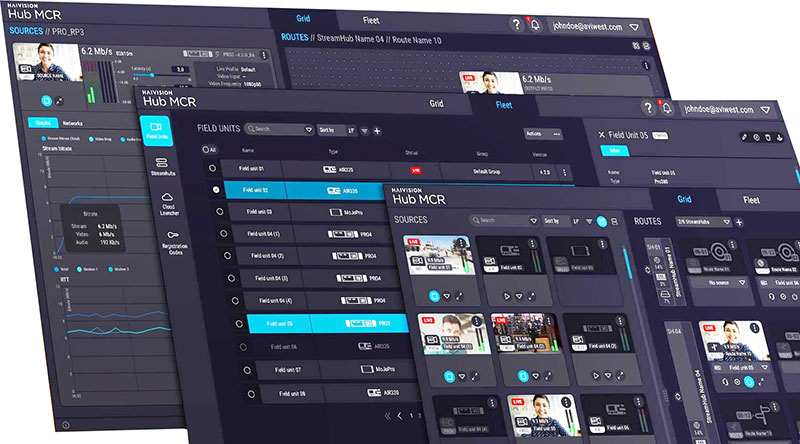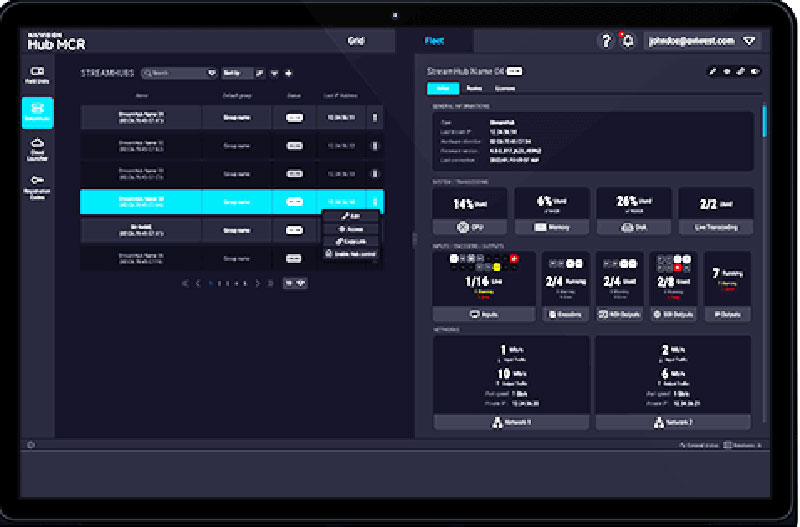Hub MCR cloud software remotely manages devices, users and streams from a single browser window, supporting mobile contribution workflows for distributed events from any location.

Haivision’s new Hub MCR is cloud-based software used to remotely manage video transmitters, video encoders, receivers, users and streams from a single browser window. Developed as a complement to Haivision’s existing Hub features, broadcasters can use it to manage their wireless transmitters and mobile contribution workflows for geographically distributed events from any location.
Functionality includes device and live stream monitoring, pairing, configuration and control. To help simplify master control room operations, Haivision Hub MCR gives comprehensive oversight and management of multiple concurrent contribution workflows in live broadcast, remote and cloud-based productions. Accessed via the cloud, this platform requires no installation and is massively scalable and elastic.
StreamHub – Live Streaming and Decoding
Haivision StreamHub is a key part of the workflow, receiving IP video streams over mobile networks and the internet. Typically deployed on-premises, StreamHub can receive and decode live SST (Safe Streams Transport) streams from Haivision Pro and Air mobile transmitters, and from Haivision Rack encoders. StreamHub can also receive live streams from Haivision’s MoJoPro mobile applications for broadcasting or recording/forwarding live video from the field, and LiveGuest, which integrates live interviews with remote guests into productions.
For Haivision’s open-source video transport protocol SRT, StreamHub receives and decodes SRT streams from Haivision encoders and third-party sources.
In April 2022, Haivision acquired StreamHub, Pro and Air devices, and MoJoPro and LiveGuest software, as part of its acquisition of AVIWEST, a specialist in mobile IP-based video contribution and live video transmission over cellular networks. The acquisition expanded Haivision’s video contribution capabilities to include 5G transmission, mobile video contribution and network bonding. AVIWEST are also the developers of SST.

In turn, introducing the Haivision SRT streaming protocol support to the Aviwest PRO, AIR and RACK series makes those devices interoperable with all Haivision and other SRT-enabled products. They can be used alongside other Haivision broadcast gear in varied scenarios, including multi-camera remote production, cloud contribution and distribution, and collaborative decentralised workflows.
Live Over Mobile Networks and Internet
With Haivision Hub MCR, users can contribute live video over mobile networks and the internet with a user interface displaying all video sources and destinations in a single grid view. Preview thumbnails are displayed for identification of video content for each input and output in order to make sure that sources are being sent to the right destination.
Through the same view, field units can be remotely configured and controlled including Pro and Air transmitters, Rack video encoders and MoJoPro mobile apps, allowing on-site camera crews and remote talent to focus on the live content they are capturing.
Monitoring and managing of StreamHub receivers and decoders is supported by access to real-time statistics and settings, and by routing feeds to SDI, NDI, ST 2110, SST, SRT and other IP outputs. Users can launch further StreamHub cloud instances for flexibility or extra capacity.
It is also possible to organise field units, receivers and users into groups dedicated to specific live broadcast productions, and to apply different roles and privileges permanently or temporarily so that users have secure access to the appropriate content.

SRT 1.5
The Haivision SRT video transport protocol, which optimises real-time streaming across unpredictable networks, was just updated to version 1.5 at the IBC2022 Show. Designed to enhance live video transport over public internet, SRT supports decentralized workflows for broadcast production, remote contribution and content distribution.
The new 1.5 updates include Connection Bonding, bringing a hitless failover approach to the SRT protocol. It can make a live video stream more reliable by routing it over more than one network path, preventing disruption to delivery should the network fail. The new implementation of the receiver buffer also increases reliability when streaming over networks by improving memory management and packet reading, latency management and the handling of drop requests.
SRT’s packet pacing and live congestion control now prioritise the order of sent packets in order to help avoid congestion if there are changes to the source bitrate or significant network bandwidth fluctuations. haivision.com




